Information in the review is provided as of October 1, 2023
Summary
In September, general activity of the Belarusian Armed Forces didn’t change significantly. During the month, major drills (with the participation of the CSTO member states and bilateral comprehensive drills) were held in Belarus, which showed that Russia and the CSTO member states are not currently interested in holding major military maneuvers with Belarus. The probable reason for this could be a lack of military resources.
The activity of the Russian Armed Forces didn’t change in September. There may still be about 2000 servicemen of the Russian Armed Forces in Belarus who are not formally part of the regional group of troops. In general, military activity of the Russian Armed Forces on the territory of Belarus can be characterized as very low. Currently, there are no signs that this situation will change dramatically. However, a dramatic change of the situation due to unpredictable events is possible.
The number of mercenaries of PMC Wagner in Belarus continued to decrease in September. There was no significant activity of mercenaries in Belarus. The number of mercenaries can be estimated at 500-1000 people.
The general medium-term forecast of the military situation in Belarus is still the same: there is no reason to expect an offensive operation by the Russian Armed Forces from the territory of Belarus. The importance of PMC Wagner as a key destabilizing factor will gradually decrease.
1. Armed Forces of the Republic of Belarus
1.1. Organization of combat training.
September was full of combat training activities of the Belarusian Armed Forces. During the month, it was reported that field drills were conducted with mechanized, engineering (1, 2), air defense (1, 2, 3), signal (1, 2) and electronic warfare units.
The most significant combat training events include the following:
1) Tactical drills with units of the Air Force and Air Defense Forces. During the first stage, which was held on the territory of Belarus, the topic of the drills was “Conducting combat operations with formations and military units of the Air Force and Air Defense Forces in the operation of the regional group of troops (forces).” As part of the second stage of the drills, combat crews from the 1st and 377th Anti-Aircraft Missile Regiments and the 15th Anti-Aircraft Missile Brigade conducted launches from S-300 SAM systems at the Telemba training ground (Russia).
2) On September 6, a tactical medicine training session was held in the 120th Separate Mechanized Brigade with officials of the medical services of units of the Northwestern Operational Command. Instructors at the training session were professors from the Department of Medical Support Organization and Disaster Medicine of the Military Medical Institute.
3) Tactical and special drills with the 74th Signal Regiment. During the drills, issues related to the organization of communications with the relocation of communications nodes and the change of their deployment areas were practiced.
4) A three-day training course on “State defense training” for representatives of various government agencies was held at the Faculty of General Staff of the Military Academy of Belarus. Such a course was held for the first time.
5) Tactical special training with a medical company of the 38th Air Assault Brigade. The purpose of the training was to practice skills in performing functional duties during medical evacuation activities.
6) Company tactical drills with the peacekeeping company of the 103rd Airborne Brigade. The drills are a control training to complete the training of the peacekeeping contingent of Belarus for participation in the CSTO drills Unbreakable Brotherhood-2023, which will be held in Kyrgyzstan in October.
7) Tactical drills with units of the 15th Anti-Aircraft Missile Brigade and 115th Anti-Aircraft Missile Regiment. During the drills, new methods of countering UAVs, repulsing attacks of sabotage and reconnaissance groups, changing positions, etc. were practiced.
Separately, we should note the following drills:
1) The CSTO joint operational-strategic drills Combat Brotherhood-2023, which were held on September 1-6 on the territory of Belarus. We should note that the number of military contingents that took part in the drills allows us to conclude that the joint and international nature of the maneuvers was nominal. For example, a small military contingent from Russia (up to 300 people) was involved in the drills. Kazakhstan, Kyrgyzstan and Tajikistan sent even smaller contingents to participate in the drills. The key role in the drills was played by units of the Belarusian Armed Forces.
For more details, see the brief dated September 15, 2023 “Joint operational-strategic CSTO drills Combat Brotherhood-2023 were held in Belarus on September 1-6.”
2) Bilateral comprehensive drills of the Belarusian Armed Forces, which were held on September 22-26. The purpose of the drills was to improve the readiness of military command bodies of operational formations to ensure continuous management of subordinate forces and means during combat operations. The drills involved units of the Western and the Northwestern Operational Commands, as well as the Belarusian Air Force.
For more details, see the brief dated October 1, 2023 “Bilateral comprehensive drills of the Belarusian Armed Forces were held in Belarus on September 22-26.”
A separate area of combat training is the use of units of the Belarusian Armed Forces to guard the border with Ukraine and the Russian military located at Mazyr (Bokau) and Ziabrauka airfields. To perform these tasks, the 38th Air Assault Brigade (Ziabrauka airfield), and probably the 5th Special Purpose Brigade of the Special Operations Forces (Mazyr (Bokau) airfield) were involved in September.
According to available information, units of the 5th Special Purpose Brigade of the Special Operations Forces were in the vicinity of Luninets and Pinsk, Brest region.
In August, units of the 103rd Airborne Brigade that had been guarding the Russian military at Ziabrauka airfield were withdrawn to the permanent deployment point. We should note that the brigade’s battalions had been in Homiel district on a rotational basis, which occurred approximately every two months, since spring 2022. In September, the 103rd Airborne Brigade was replaced by the 383rd Air Assault Battalion of the 38th Air Assault Brigade. For example, since the beginning of September, we have been receiving information about cultural activity of the unit in Homiel and its vicinity in late August-early September (1, 2, 3). It was also reported about drills with the 38th Air Assault Brigade in Homiel district.
PMC Wagner continued to train units of the Belarusian Armed Forces and Internal Troops. It is known about mercenaries’ training in the 38th Air Assault Brigade of the Belarusian Armed Forces. Also, training and refresher courses for servicemen of special purpose units of the Internal Troops were held with the participation of mercenaries of PMC Wagner. It was reported that more than 400 people underwent training.
It is important to note that a number of trainings were conducted with non-military structures. These could include the following:
- training on tactical medicine with journalists;
- training with students of the Rys’ military-patriotic club;
- training with representatives of the National Beauty School.
There were no reports about joint combat training events between the Belarusian Armed Forces and Russian Armed Forces included in the regional group of troops.
No specifics of the organization and conduct of combat training of other agencies (Internal Troops, Border Guard Service) were observed.
1.2. Organization of training sessions with reservists.
During the month, it was reported about training sessions with reservists in:
- The 320th school of the 72nd Joint Training Center (at least 20 reservists);
- The 258th Guard and Service Battalion (at least 14 reservists);
- The 288th Vehicle Reserve Base (at least 23 reservists);
- The 46th Missile and Ammunition Arsenal (at least 10 reservists);
- The 2nd Engineering Brigade (at least 14 reservists);
- The 7th Engineering Regiment (at least 5 reservists);
- The 120th Mechanized Brigade (at least 8 reservists);
- The 1371st Engineering Base (at least 25 reservists);
- Military Academy of Belarus (at least 25 reservists);
- The 1868th Artillery Weapons Base (at least 11 reservists).
There was information about sending reservists to military training sessions by military commissariats of Brest (1, 2), Homiel regions and Minsk (1, 2, 3, 4). In total, at least 83 reservists were sent to training sessions.
According to clarified information, about 50 reservists were drafted for the training session, which was held in August-September at the 2657th Fuel Base. It was also reported about the selection of candidates for military training sessions on equipment maintenance at the 391st Artillery Ammunition Base.
We should also note that territorial defense training sessions were held in September in three districts of Mahiliou region. At least 323 reservists were drafted from the reserve (for details, see paragraph 1.4 of the review).
It is also known that military training sessions with reservists could have been held at the Training Center of the Institute of Border Guard Service. It was also reported that the 2nd Militia Brigade of the Internal Troops held a ten-day mobilization readiness training session. About 100 reservists were drafted for the training sessions.

The total number of reservists drafted for training sessions in September can be estimated to be at least 661 people. We note that this is the lowest number of reservists, since we don’t know about all the military training sessions that have been held. TIn reality, the number of reservists who have passed military training sessions could be several times higher.
In total, at least 9820 people have already been drafted for various types of training sessions from January to September 2023. Earlier, the Ministry of Defense of Belarus reported about its plans to draft 9000 people for training sessions in 2023. Thus, the limit on the draft of reservists for training sessions has already been exceeded.
1.3. Movements of military equipment and aviation activity.
The intensity of movements of military equipment increased compared to August. This was primarily related to the bilateral comprehensive drills of the Belarusian Armed Forces and the CSTO drills Combat Brotherhood-2023 (for details, see paragraph 1.1 of the review). In general, as in previous months, there was nothing unusual about the movements of equipment of the Belarusian Armed Forces. More details on the movements of military equipment are available on the map of military activity.
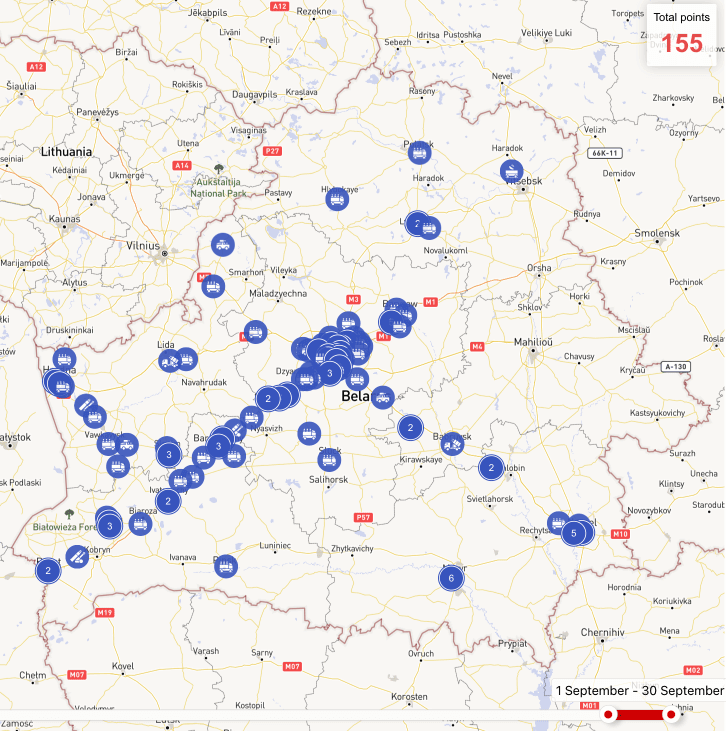
The intensity of movements of the Belarusian Armed Forces by rail also increased compared to August. This was related both to major drills that were held in Belarus in September and to the conduct of field drills outside the permanent deployment points. Among the most significant movements by rail, we can note the withdrawal of units of the 103rd Airborne Brigade from Ziabrauka airfield to their permanent deployment points (for details, see paragraph 1.1 of the review).
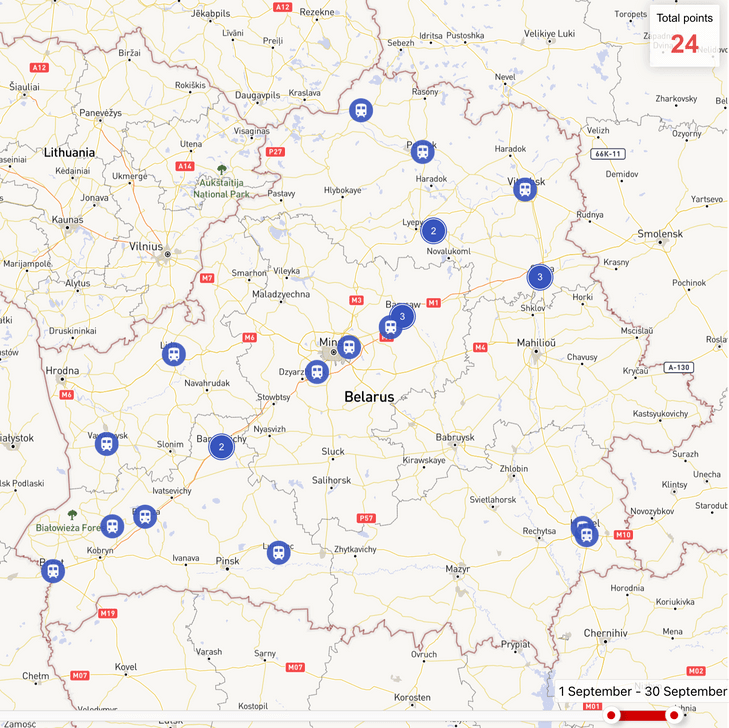
The intensity of flights of the Belarusian Air Force also increased compared to August due to several major drills, in which units of the Belarusian Air Force were actively involved. Lida, Baranavichy, Machulishchy and Barautsy airfields were mainly used for flights. During the flights, the entire helicopter and aircraft fleet of the Belarusian Air Force was involved. In general, there was nothing unusual during the flights.
In September, the repair of the runway began at Machulishchy airfield. Due to this, aircraft of the 50th Combined Air Base of the Belarusian Air Force were temporarily redeployed to Baranavichy airfield.
Aviation incidents with violation of the airspace of Poland and Belarus continued. For instance, on September 1, the State Border Committee of Belarus reported that a helicopter of the Polish Air Force flew into the territory of Belarus. On September 28, the Ministry of Defense of Belarus reported a similar incident. We note that in both cases we can’t unequivocally state that the Polish Air Force helicopters indeed violated Belarus’ airspace.
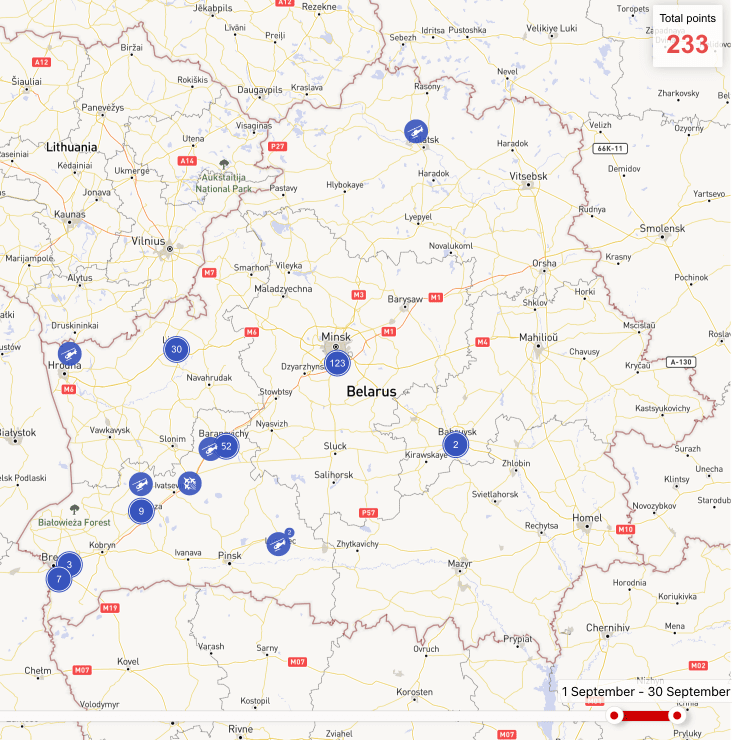
1.4. Military commissariats. Territorial defense and national home guard.
In September, drills with the territorial defense and national home guard were actively conducted. Among them, we can mention a training session with reservists of the territorial troops, which was held on September 5-27 in three areas of Mahiliou region – Mahiliou city, Asipovichy and Chavusy districts. About 100 reservists from Chavusy and Slauharad districts, 123 from Asipovichy district, and at least 100 more from Mahiliou were drafted for the training session.
The training session ended with command staff drills with the territorial defense forces of Mahiliou region, which was held on September 22-25. Officials of executive committees and military commissariats of the region, reservists of the territorial defense forces, as well as two units of the national home guard took part in the drills. Traditionally for such drills, they practiced the issues of protection and defense of infrastructural objects, ensuring martial law measures, and fighting against sabotage and reconnaissance groups. A specific aspect of the drills was the firing by artillery units of the territorial defense armed with 82-mm 2B9 Vasilyok mortars. It is notable that the drills involved the equipment of PMC Wagner mercenaries.
It should also be noted that on September 25, a one-day training session on territorial defense was held in Asipovichy district with representatives of executive committees and military commissars of Mahiliou region. The participants of the training session were shown modern and promising models of weapons, equipment and gear of the territorial defense, including UAVs and anti-drone systems.
Also, on September 11-13, command staff drills were held as part of the training session with reservists of the territorial defense troops of Polatsk district, Vitsiebsk region.
We should note that since the beginning of the year, territorial defense drills have been held in 11 regions of Belarus. About 1287 reservists were drafted from the reserve for these drills.
As for the activity of military commissariats, first of all, we should mention the autumn conscription for active service, which is coming to an end. For example, more than 600 out of about 1600 conscripts in Minsk district will receive deferments, and only 200 people will be drafted. About 7000 people will be drafted in Vitsiebsk region, most of whom will receive a deferment to continue their education. In total, 1000 people will be drafted for military service.
It was reported about at least 13 criminal cases against citizens who evade conscription for active military service in September. The Ministry of Defense of Belarus has not yet announced any plans regarding the number of conscripts planned to be drafted.

1.5. Supplies of new military equipment to the troops. Activity of the military-industrial complex.
Supplies of new military equipment to the troops.
There were almost no reports of major deliveries of new military equipment to the Belarusian Armed Forces in September. It is only known about the transfer of new MAZ-5316 trucks to the 1146th Anti-Aircraft Missile Regiment and 103rd Airborne Brigade.
Based on the available information, we may assume that the Belarusian Air Force will receive another batch of four Mi-35M helicopters in October. We recall that the Belarusian Air Force received the first batch in August 2023. Today, the Mi-35M is the most modern helicopter in service with the Belarusian Air Force.
It became known which unit of the Belarusian Armed Forces received the Iskander-M missile system. It was the 587th Separate Missile Divizion of the 465th Missile Brigade. It is known that the divizion was formed on December 1, 1991 as part of the 465th Missile Brigade. As of 2013, it was reported to have been disbanded. Most likely, the divizion was re-established due to the entry of Iskander-M missile systems in service with the 465th Missile Brigade.
Activity of the military-industrial complex.
1) On September 6, the State Committee for Military Industry showed its developments at the exhibition of military equipment organized for the participants of the Combat Brotherhood-2023 drills. The new models included an artillery fire control vehicle based on the Manul universal combat platform. The complex includes means of reconnaissance and orientation (including Supercam C350 UAV), control (several radar stations) and preparation of firing and fire control. The arrival of the vehicle to the troops has not yet been reported.
2) The enterprise of the State Committee for Military Industry (KB Display) is preparing to launch a production line for the small-scale manufacture of the Kvadro-1400 and Barraging Tube attack UAVs. Both models entered service with the Belarusian Armed Forces in 2022.
1.6. Amendments to the legislation in the military sphere.
1) On September 19, Belarus suspended the CFE Treaty with Poland and the Czech Republic. The decision was justified by “the purposes of ensuring the national interests of the Republic of Belarus.”
The suspension of the treaty means that Belarus won’t provide Poland and the Czech Republic with notifications and information related to conventional arms and equipment, as well as accept inspections from these countries in order to monitor compliance with the quantitative limitations on conventional arms established by the CFE Treaty.
2) On September 25, a decree was signed, which prohibits individuals from importing, storing, operating and manufacturing UAVs on the territory of Belarus. From now on, these actions are allowed only to legal entities (organizations, individual entrepreneurs) for entrepreneurial or professional activities.
The ban on the use of UAVs was a consequence of the sabotage against the A-50 AEW&C aircraft of the Russian Aerospace Forces, which occurred at Machulishchy airfield in February 2023.
1.7. International cooperation.
1) On September 11, a delegation of defense attachés from 14 African states (Egypt, Zimbabwe, South Africa, etc.) arrived in Minsk. The purpose of the visit was to review the capabilities of Belarus to develop cooperation in the military sphere. As part of the visit, the attachés visited a number of enterprises and educational institutions.
2) On September 18-22, a delegation of the Vietnamese Ministry of National Defense headed by Deputy Head of the Main Logistics Department of the Vietnamese People’s Army Nguyen Hung Thang was on a working visit to Belarus. During the visit, the delegation held negotiations and visited the 2336th Material Storage Base of the Belarusian Armed Forces.
3) On September 29, a meeting of the Council of Defense Ministers of the CIS member states was held in Tula (Russia). The meeting was attended by a delegation from Belarus headed by Defense Minister Viktor Khrenin. The meeting resulted in the approval of the Work Plan of the Council of Defense Ministers of the CIS member states for 2024.
1.8. Tactical nuclear weapons in Belarus.
The following information regarding the deployment of TNWs in Belarus was received in September:
1) On September 7, Russian Deputy Foreign Minister Sergei Ryabkov said that the work on the deployment of Russian TNWs in Belarus was going on according to the established schedule. According to the official, several stages have already been “passed in terms of creating relevant infrastructure and re-equipping relevant carriers.”
2) On September 17, Deputy State Secretary of the Security Council of Belarus Pavel Muraveiko said that Belarus had received nuclear warheads from Russia. Belarusian military specialists underwent a full cycle of training, practiced a set of measures on simulators and real objects, having received the appropriate capability to use TNWs.
3) According to the Community of Railway Workers of Belarus, in late August-early September 2023, another stage of transportation of TNW components to Belarus began. All the work was carried out with maximum secrecy. For example, for this purpose, the data on the train with TNWs were changed several times during the train’s transit, so that it was impossible to trace the point of its departure. In total, from August 26 to September 5, at least 5 trains that could have delivered TNW components to Belarus were recorded. The final destinations of the trains were Baranavichy-Palesskiya and Luninets stations.
The currently available information doesn’t allow us to state unequivocally that Russian TNWs are already on the territory of Belarus. At the same time, a number of preparatory activities for its deployment have already been carried out.
2. Armed Forces of the Russian Federation
2.1. Russian component of the regional group of troops in Belarus.
The situation with the Russian component of the regional group of troops in Belarus didn’t change in September. There was no redeployment of military contingents to Belarus during the month.
There are no grounds to believe that the Russian Armed Forces will start arriving in Belarus in large numbers in the near future. At the same time, it is possible that if a new wave of mobilization is announced in Russia, the infrastructure of the Belarusian Armed Forces will be used again to train mobilized Russians.
We should recall that in July, the Ministry of Defense of Belarus announced the upcoming arrival of a “new shift” of the Russian military to the training grounds in Belarus for joint combat training. However, as of early October, this didn’t happen.
We note that in Belarus, Russian military are still stationed at Mazyr (Bokau) and Ziabrauka airfields. Formally, these units are not part of the regional group of troops.
Also, Russian servicemen continue to operate the Baranavichy radar station and the Russian Navy’s 43rd communication center in Vileika.
Thus, as of October 1, the number of Russian military personnel stationed in Belarus didn’t change and can be estimated at about 2000 people. Of these:
- from the regional group of troops – 0 (no data on the deployment of the Russian contingent of the regional group of troops in Belarus);
- at Mazyr (Bokau) and Ziabrauka airfields – up to 600 people;
- at the Baranavichy radar station and the Russian Navy’s 43rd communication center in Vileika – up to 1450 people.
Currently, there is no information that the Russian military contingent, which participated in the CSTO drills Combat Brotherhood-2023, stayed on the territory of Belarus.
2.2. Movements of military equipment and aviation activity.
The intensity of movements of military equipment by public roads remained almost the same as in August. We can state that due to the decrease in the number of Russian military in Belarus, only single movements of equipment of the Russian Armed Forces are recorded. A significant part of them was detected in the vicinity of Mazyr, where an air defense unit of the Russian Armed Forces is located (for details, see paragraph 2.1 of the review). More details on the movements of military equipment are available on the map.
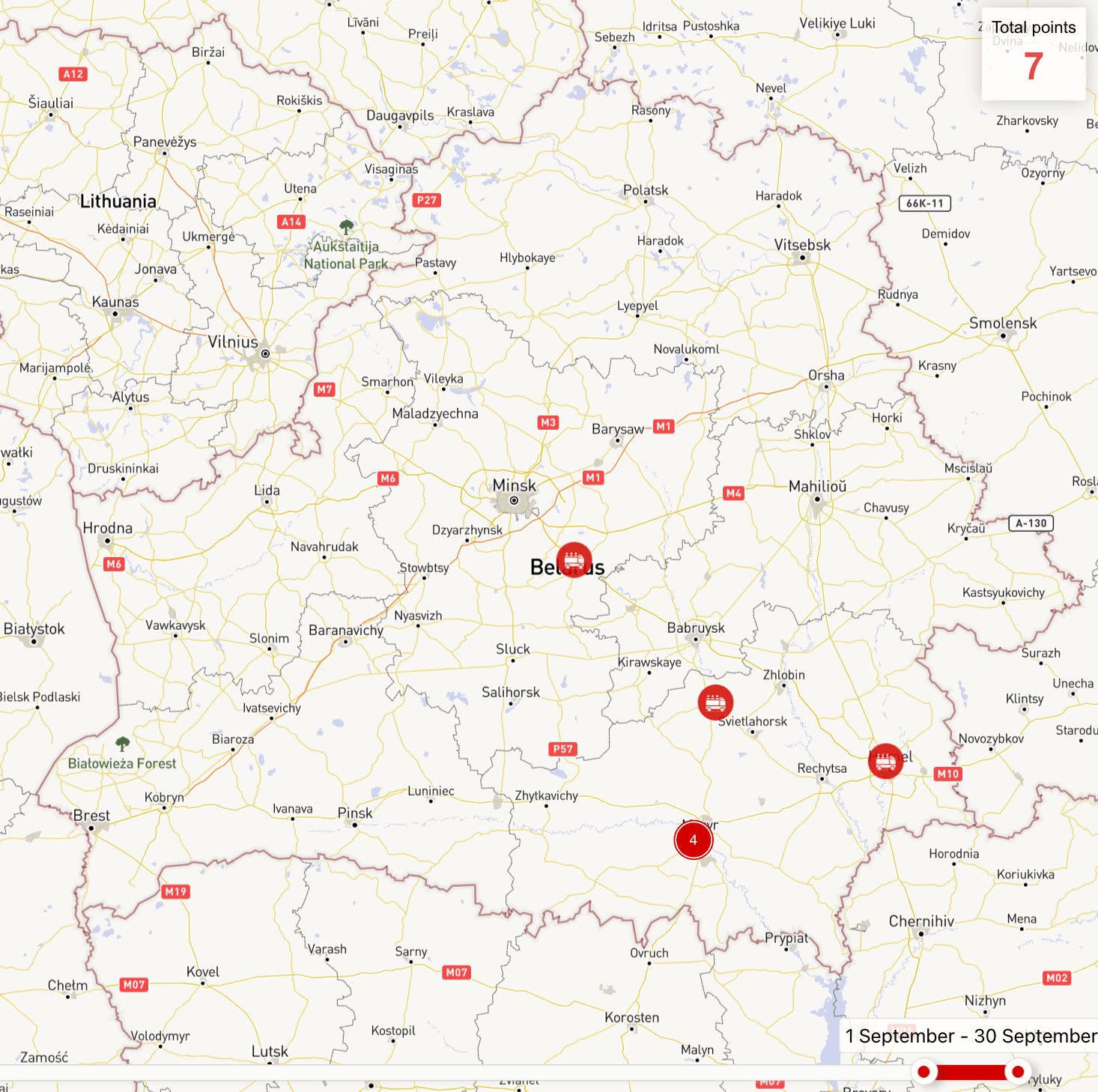
There were also practically no movements of the Russian Armed Forces by rail recorded in September. This is primarily explained by a significant reduction in the number of Russian military stationed in Belarus.
The aviation activity of the Russian Aerospace Forces decreased twofold in September compared to August. According to our data, as of October 1, there is one Su-25 attack aircraft of the Russian Aerospace Forces permanently stationed on the territory of Belarus, which arrived at Machulishchy airfield on July 25. On August 31, the aircraft flew to Lida airfield. The purpose of the aircraft’s arrival is unknown.
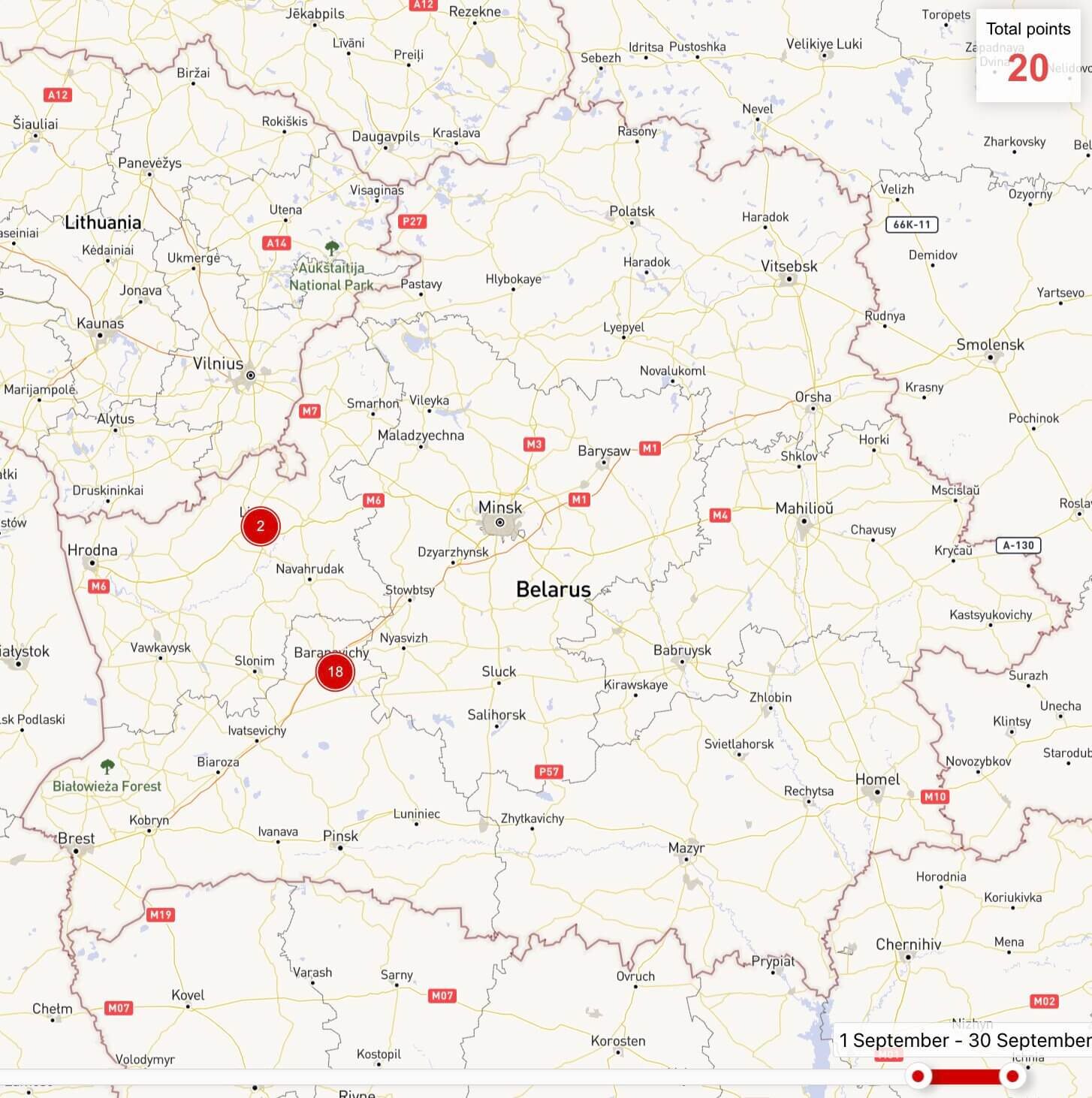
Military transport aircraft of the Russian Aerospace Forces kept arriving at the airfields of the Belarusian Armed Forces and civilian airports. According to our data, the aircraft arrived at:
Baranavichy airfield: transport – 1 An-26, 8 Il-76;
Lida airfield: passenger – 1 An-12;
Brest airport: passenger – 1 Tu-134AK.
As we can see, almost all the aircraft of the Russian Aerospace Forces arrived at Baranavichy airfield. This is explained by the ongoing repair of the runway at Machulishchy airfield (for details, see paragraph 1.2 of the review).

As we can see, the number of arrivals of military transport aircraft in September remained almost the same as in August. At the same time, most of the arrivals were connected with the transfer of servicemen of the CSTO member states to take part in the drills Combat Brotherhood-2023 and also to deliver servicemen to the Telemba training ground (for details, see paragraph 1.1 of the review).
During the month, no arrivals of military transport aircraft of the Russian Aerospace Forces at Homiel airport were recorded. The dynamics of arrivals of the Russian Aerospace Forces aircraft at Homiel airport since August 2022 can be seen in the chart.
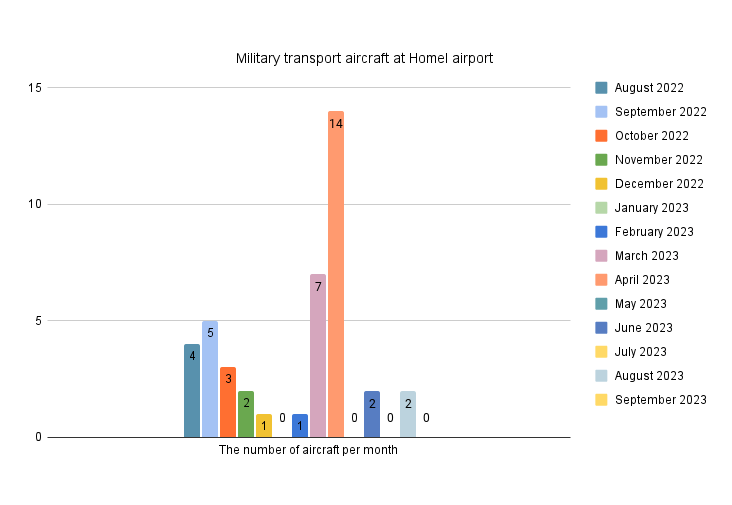
3. Private military company Wagner
In general, the situation with mercenaries in Belarus hasn’t changed significantly.
For example, the dismantling of the mercenaries’ field camp located in Tsel village continued. As of September 30, about 99 tents were left in the mercenary camp, or 34% of their original number. Therefore, about 30 tents (1, 2) were dismantled in September. At the same time, there were originally about 292 tents in the camp. No construction of field camps for mercenaries has been observed at the moment. It is possible that some of the mercenaries may have moved to barracks on the territory of the former military town in Tsel village, as well as to the Asipovichski training ground, where the construction of field accommodation sites was previously detected.
The dismantling of the field camp of PMC Wagner in Tsel village started at the end of July, two weeks after the beginning of active transfer of mercenaries to the territory of Belarus. This may mean that the initially planned number of mercenaries of about 8000 people just didn’t arrive in Belarus.
We note that the number of vehicles in the camp almost didn’t change. We can observe that the vehicles were moved to the northern part of the camp, where tents were previously set up.
The intensity of training of Wagner mercenaries with units of the Belarusian Armed Forces is low and not systematic. In turn, we can note a more active interaction of mercenaries with the Internal Troops (for details see paragraph 1.1 of the review).
On September 27, a representative of the State Border Guard Service of Ukraine said that about 500 mercenaries of PMC Wagner were left in Belarus. Some of the mercenaries who left Belarus for Russia signed contracts with the Russian Ministry of Defense, and now take part in hostilities against Ukraine. In other words, it is not PMC Wagner (as a structure), but its former representatives who take part in the hostilities.
According to our estimates, there may be from 500 to 1000 mercenaries of PMC Wagner on the territory of Belarus.
During the month, several informational provocations related to the creation of spontaneous memorials to Dmitry Utkin and Yevgeny Prigozhin in Minsk and Homiel were detected.
No active movements of PMC Wagner mercenaries on the territory of Belarus were recorded.
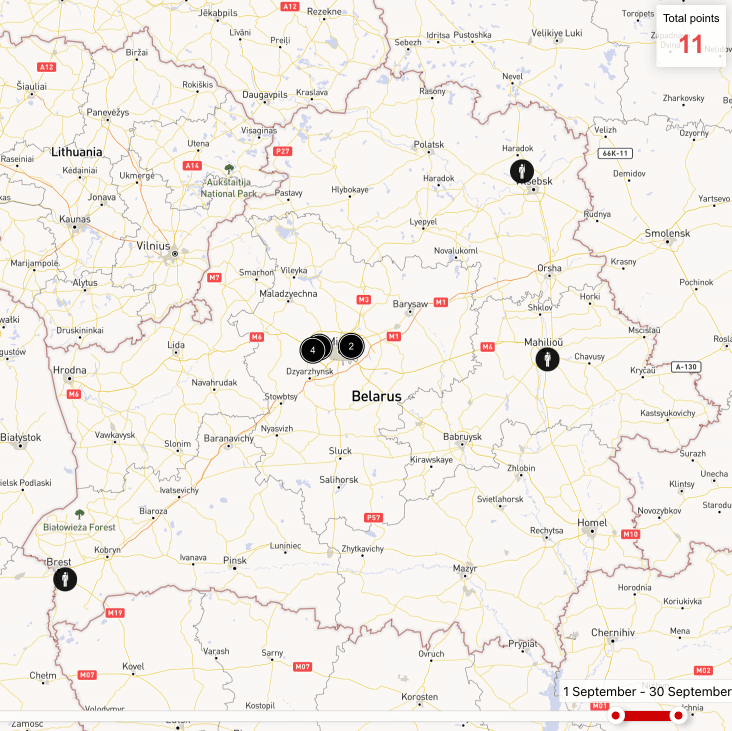
4. General conclusions
- In September, two major drills were the main events among the activities of the Belarusian Armed Forces. Military contingents of the CSTO member states were nominally represented at the CSTO drills Combat Brotherhood-2023, the Belarusian Armed Forces were the main contingent. The available information indicates that the bilateral comprehensive drills were held instead of the canceled drills Union Shield-2023, which were to be held in Russia.
The drills showed that:
- CSTO member states have little desire to conduct joint maneuvers with Belarus and Russia;
- Russia probably does not currently have the capacity to conduct major demonstrative drills with Belarus.
- The general conclusion about the situation of the Russian Armed Forces on the territory of Belarus didn’t change. The deployed Russian units do not pose a significant threat to Ukraine and other countries bordering Belarus. At the moment, an increase in the number of the Russian contingent in Belarus may occur, for example, if a new wave of mobilization in Russia is announced. We should remember that the increase of the Russian forces in Belarus may occur at any moment as a result of unforeseen and unpredictable events.
The level of activity of the Russian Armed Forces in Belarus can be characterized as very low.
- We can state that the presence of Wagner mercenaries won’t be realized according to the original agreements between Lukashenko and Prigozhin (their content is not exactly known). The number of mercenaries in Belarus is decreasing. A significant part of them has already returned to Russia (to participate in combat operations as part of structures, for example, of the Russian Ministry of Defense), or went to Africa to participate in combat operations there.
Actually, a small number of mercenaries of PMC Wagner stays in Belarus, which will integrate into the security forces of the Lukashenko regime as full-time instructors. It is possible that they will be able to receive Belarusian passports (earlier the media spread such information), and stay to work in Belarus. Earlier, former employees of Ukrainian police units, who left Ukraine after the events of 2014, joined the security forces of the Lukashenko regime under such a scenario.
We can state the reduction of potential threats that may come from the mercenaries of PMC Wagner left in Belarus.
In general, the level of activity of PMC Wagner in Belarus can be characterized as low.
